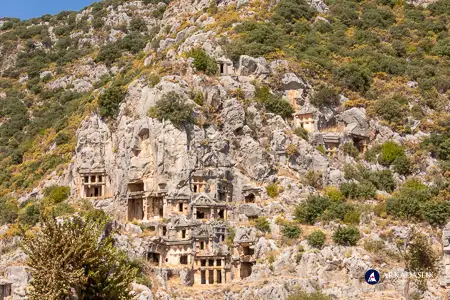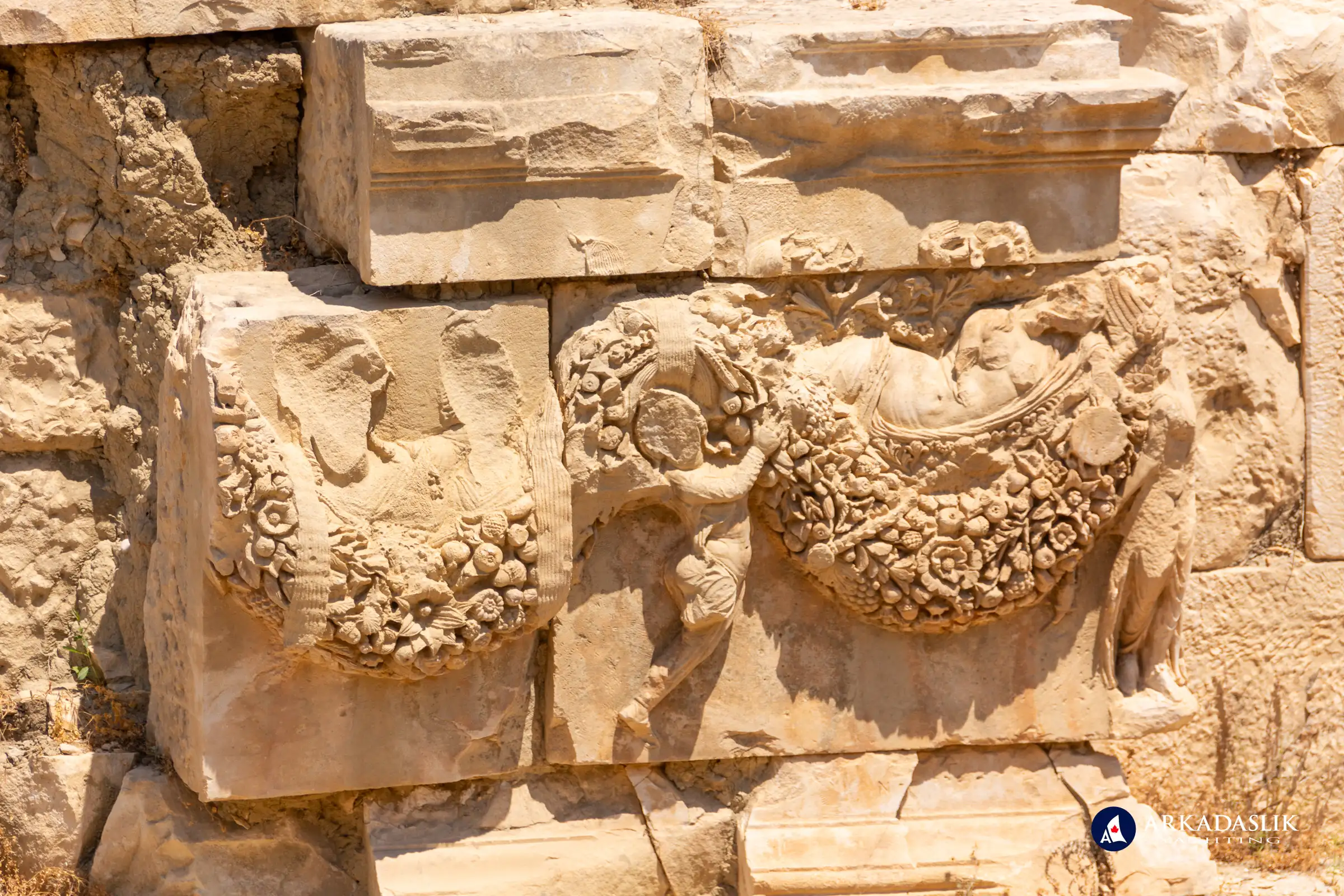Exploring Myra – A Portal to Lycian Civilization
Located in the heart of Demre, Turkey, Myra is a treasure trove of ancient history and cultural significance. Once a prominent city in the Lycian Union, much of its past lies hidden beneath the fertile plains of the Myros River. Yet, what remains above ground provides an incredible glimpse into its storied past.
Today, visitors are drawn to Myra for its archaeological wonders, rich Lycian heritage, and nearby attractions like the St. Nicholas Church Museum, making it an essential stop for history enthusiasts.
The Many Facets of Myra
Myra’s historical and cultural layers reflect its dynamic role in the ancient world:
- A Vibrant Lycian City: Myra was among the most influential cities of the Lycian League, renowned for its prosperity and advanced governance. Its strategic location on fertile plains allowed it to thrive as an agricultural hub. Today, modern Demre continues this legacy with its abundant production of tomatoes, cucumbers, and citrus fruits.
- A City Beneath the Surface: Over centuries, the Myros River deposited layers of silt that buried much of ancient Myra, leaving the city roughly 10 meters below modern-day Demre. While the visible ruins, such as the Greco-Roman theatre and rock tombs, tell a captivating story, most of Myra remains hidden beneath the streets of the modern village, waiting to be discovered.
- A Biblical Connection: Myra is mentioned in the New Testament as the port where St. Paul changed ships during his journey to Rome. The nearby Andriake harbor played a crucial role in connecting Myra to Mediterranean trade routes.
- Architectural Marvels: Myra’s ancient ruins are a testament to its importance. The Greco-Roman theatre, the largest in Lycia, could seat up to 12,000 spectators and features intricate stonework that has survived centuries. Nearby, the famous Lycian rock tombs carved into steep cliffs display stunning artistry and insights into ancient burial customs.
- The Legacy of St. Nicholas: Myra is also known as the home of St. Nicholas, the 3rd century bishop whose generosity inspired the legend of Santa Claus. The St. Nicholas Church, in Demre, is a major pilgrimage site and an important Christian landmark, featuring beautiful frescoes and intricate carvings.
- A Tragic Decline: A series of disasters — including a plague in the 6th century and Arab raids — led to Myra’s gradual abandonment. By the 11th century, the once-prosperous city had faded into obscurity.
The Theater of Myra – A Cultural Masterpiece
The Greco-Roman theater at Myra is a testament to the city's prominence in the ancient world and its thriving cultural scene. As the largest theater in Lycia, it once accommodated up to 12,000 spectators, hosting dramatic performances, musical competitions, gladiatorial games, and civic events. Its grand scale and intricate design make it a highlight of any visit to Myra.
Carved into the natural slope of the landscape, the theater features a semi-circular cavea (seating area) divided into two tiers, connected by stairways that provided easy access to the rows. Despite the passage of centuries, the theater’s superb acoustics remain evident, allowing sound to carry clearly even to the uppermost seats. Visitors can sit where ancient Lycian and Roman audiences once gathered and imagine the lively performances that brought the stage to life.
The theater was damaged by a significant earthquake in 141 AD but was rebuilt and expanded during the Roman period. Today, remnants of its skene (stage building) offer a glimpse into its former grandeur, with decorative reliefs and inscriptions commemorating benefactors and events. Some carvings depict theatrical masks and mythological themes, offering insight into the artistry of the time.
Today, ongoing archaeological excavations continue to reveal new insights into the theater's structure and use. These efforts are helping to preserve the theater for future generations and uncover the layers of history still buried beneath the site. Visitors can appreciate both the preservation of the theater and the active work being done to better understand this ancient cultural hub.
Beyond its architectural brilliance, the theater provides a striking vantage point for viewing the iconic Lycian rock-cut tombs that surround the site. This blend of cultural, architectural, and natural beauty makes the theater an unmissable part of exploring Myra.
Myra’s Iconic Rock-Cut Tombs
The rock tombs of Myra, carved into the sheer cliffs above the ancient city, are among the most recognizable landmarks of Lycia. These tombs, dating back to the 4th century BC, showcase the Lycian belief in an elaborate afterlife. Elevated high on the cliffs, they were thought to aid the souls of the departed in their journey, guided by mythical winged creatures. The intricate facades mimic the architecture of Lycian homes and temples, blending artistry with cultural significance.
Many of the tombs were originally painted in vivid colors like red and blue, traces of which can still be seen today. Some feature relief carvings of daily life or funerary scenes, offering a glimpse into the lives and beliefs of the ancient Lycians. Among the most notable is the "Lion’s Tomb," adorned with protective lion motifs. Despite centuries of exposure to the elements, these tombs remain remarkably well-preserved and continue to captivate visitors with their historical and artistic grandeur.
The Legacy of St. Nicholas in Myra
Though much of the city’s original splendor is lost, Myra’s most enduring legacy is its connection to St. Nicholas. As the bishop of Myra in the 3rd century, St. Nicholas inspired countless legends of generosity and kindness, eventually becoming the figure we know as Santa Claus. The St. Nicholas Church Museum, located in Demre, draws pilgrims and history enthusiasts alike. This 6th century Byzantine structure features striking frescoes and intricate carvings, making it one of the most significant Christian landmarks in the region.
Modern Demre: The Gateway to Myra
Today, the town of Demre retains a quiet charm, offering a blend of modern life and ancient heritage. Its bustling markets, where local farmers sell fresh produce, and its friendly atmosphere make it an inviting stop for travelers. Though relatively small, Demre serves as the portal to Myra and its iconic landmarks.
While Myra’s visible ruins captivate visitors, the ancient city itself largely lies undiscovered beneath modern Demre. As you wander through the village’s peaceful streets, it’s fascinating to imagine the layers of history hidden beneath your feet, where bustling Lycian markets and Roman streets once stood.
Visitors to the quaint town can stroll through Demre’s peaceful streets, sample local cuisine featuring fresh Mediterranean ingredients, and enjoy the surrounding natural beauty. The silted mouth of the Myros River has given rise to a protected bird sanctuary, where wetlands now attract migratory birds and other wildlife, offering visitors a chance to connect with nature alongside the area's historical wonders.
A Photo Tour of the Ruins of Ancient Myra
Immerse yourself in the grandeur of Myra with our photo gallery, featuring highlights like the imposing Greco-Roman theatre and the breathtaking Lycian rock-cut tombs. Experience the artistry and ingenuity of the ancient Lycian civilization in vivid detail.
Click on any image to expand.























Plan Your Journey to Myra
Myra offers an unforgettable journey through ancient history, blending the architectural brilliance of the Lycians with spiritual landmarks tied to St. Nicholas. Whether you’re captivated by the rock-carved tombs, the grandeur of the theatre, or the quiet charm of modern Demre, Myra is a destination that leaves a lasting impression.
Include Myra on your next Kekova cruise and experience the magic of this ancient city for yourself. Ask us about adding Myra to your itinerary for a cultural and historical adventure like no other.























